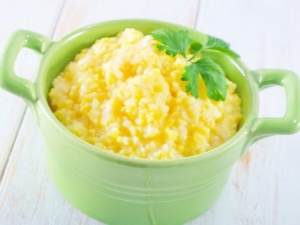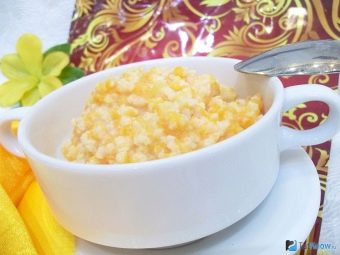Millet porridge during breastfeeding: properties and recipes of cooking

Since ancient times, millet is cultivated.Gold groats were grown by the Chinese as early as the 5th century BC. From this article you will find out whether millet porridge can be used during breastfeeding.
Special features
Today, millet grains are well known and widely used. However, in order to take place on the shelf of a supermarket or store, they must be processed in one of several ways.
- Grains of millet are cleared of films - it turns out raw materials, which is characterized by luster and rich yellow color. This type of processing allows you to save a maximum of vitamins, trace elements and fiber.
- Processing by grinding - is that the seeds are cleaned from the film, germ and grain shell in full. After such a cleaning, millet acquires a light yellow color. It has a rough surface. Such a product is easily digested, but contains less nutrients than in the first case.
- Crushing - millet kernels are crushed. In this form, the process of cooking cereals is accelerated - as a result of its cooking, semi-liquid porridge is obtained.
- Pressing is a process that is accompanied by exposure to high temperatures. As a result of pressing, flakes are obtained. When using this product, you only need to fill it with warm water or milk. The disadvantage of this type of processing is that the flakes contain a minimum supply of nutrients.
Composition and use
The use of millet during the period of breastfeeding is recommended by specialists in diet nutrition and allergists. After all, this product contains a number of trace elements, as well as vitamins, vital for the health of the newly-made mommy and her baby.
Millet is an easily digestible product that has a tonic effect and ensures the elimination of toxins from the body.
This cereal contains many nutrients.
- Protein - building material, important for the growth and full physical development of the infant.
- Cellulose - contributes to the harmonious work of the intestine, prevents flatulence, diarrhea, constipation. It contributes to cleaning the body of toxins and the removal of harmful substances from it. For a long period does not feel hunger.
- Vitamins of groups B and PP - provide full growth and harmonious development of the crumbs in the infancy.
- Fluorine - participates in the processes associated with the formation of bone tissue.
- Iron - It is important to ensure the process of blood formation and the formation of the immune system.
- Calcium - provides the required blood clotting, necessary for the formation of the epidermis, nails, hair, teeth, eye lenses.
- Copper - It plays an important role in the formation of red blood cells, promotes the absorption of iron.
- Manganese - participant of metabolic processes, affects the stable activity of the central nervous system, improves reflex function, helps to improve memory.
- Silicon - increases the elasticity of tendons, as well as tissues such as muscle, ectodermal, skin tissue.
- Zinc - helps to improve the condition of the skin, growth of bones and muscles. Participates in the immune system. Ensures the functioning of olfactory and taste receptors, protects the liver from harmful effects.
- Potassium - helps the body cells to stock up on the necessary electrolytes, provides the fight against allergens.
- Folic acid - trace element, which is necessary for the growth of karapuz tissues.
- Collagen - provides skin elasticity, is necessary for the synthesis of melanin, is responsible for the formation of blood vessels and ectodermal tissues.
For mom, this cereal is also useful in that it helps solve existing problems with the gastrointestinal tract. It improves its appearance, including a positive effect on the condition of skin and hair, accelerates the process of recovery of the body after childbirth.
The use of millet in the lactation period
In a young nursing mom, the primary question is how to eat, so as not to harm the baby in a random way, but, on the contrary, to strengthen and heal the fragile children's organism by using certain foods. There is no doubt about millet porridge - it is a nutritious and healthy product. Use it not only possible, but necessary (subject to the absence of individual intolerance). In this case, you should follow a number of rules that will help organize the process of use most effectively.
- For the first time, it is enough to take half a serving, to see how the infant reacts to this food. Millet does not belong to products that cause allergies, but wheat protein in some cases can cause a negative reaction in the crumbs in the form of redness, rash, excessive gas formation, colic, or abdominal pain. In this case, you should delay the introduction of this product into the diet.
- In the absence of a negative reaction in the infant, one can safely eat the millet porridge starting with a smaller portion of the portion (50 g), gradually increasing it to the daily consumption rate of the product (150 g).
- In the first three months of the baby’s life, it is recommended to boil the porridge in water, since the protein contained in the milk can cause a strong allergic reaction in the infant.
The best option is to gradually switch from water to milk: with each new batch, take more milk component and less water component, thus making a smooth transition to the milk version of cereal.
- Over time, dried fruits (raisins, dried apricots, prunes) or fresh fruits and vegetables (apples, pumpkin) can be added to the millet porridge. This should be done gradually starting with a few grams. Sugar, salt, butter are added either in small quantities, or complete abandonment of them is possible. You can use for cooking porridge beef broth to enhance its nutritional value.
- It is contraindicated in eating with diseases of the digestive system, including ulcers, gastritis, acute inflammatory processes in the intestine.
- Caution in use does not hurt even with problems with the thyroid gland, since millet can interfere with the process of iodine uptake.
- The grits, which are planned to be used for cooking, should be of good quality. It is important to pay attention to the shelf life, the integrity of the package when buying this food product.
- The color should be taken into account: from bright yellow kernels you get thick rich porridge, if the cereal is darker - the dish will be more crumbly, light millet will give the finished product of semi-liquid consistency.
Possible harmful effects of millet
Millet is considered to be an exceptionally useful product, but there may be danger in it.
For storage of cereals should find a dry, well-ventilated place, which does not penetrate the direct rays of the sun. It is important to prevent the appearance of pests in it, as well as its dampness. Under inadequate storage conditions, damage to the product is possible, as a result of which its nutritional value is lost. Mothers who breastfeed cannot in any case eat damp and rancid millet for food.
Another aspect is the cooking process itself. Millet, of course, a dietary product, but if you abuse the fats of vegetable and animal origin in its preparation, used as a side dish for fat pork meat, then this dish will not contain a small amount of calories. This will lead to weight gain - a problem from which the lion's share of mothers after childbirth suffers.
How to cook?
The cooking process begins with the processing of grain: it should be thoroughly cleaned. For this purpose, a glass of cereal should be filled with a glass of water. The cereal, poured with water, is placed on the fire until boiling. After that, the boiling water is drained, and the millet is to be washed in running water.
There is another way to pretreat the millet, allowing you to save all the beneficial properties of cereals, as well as get rid of its inherent bitterness. Millet is placed in cold water and left overnight. In the morning, the soaked cereal is washed and cooked.
The process of cooking ordinary millet porridge is simple: the treated cereal is poured with water at a ratio of 2 to 1. The cooking container with the lid previously removed is put on fire. After ten minutes after the water boils, butter is added. The fire is turned off, and the pan is covered with a lid. After half an hour the product is ready for use.
Consider the possible options for cooking porridge on water with the addition of no less nutritious and useful ingredients.
Pumpkin porridge
Such porridge is not only nutritious, but also tasty and pleasant to taste.
It should be remembered that the peeled pieces of pumpkin are cooked separately. The readiness of the vegetable is determined by piercing the fork in several places. Ready, rather soft vegetable kneads until a homogeneous mass (similar to mashed potatoes). This mass is combined with boiled millet. The resulting mixture is heated on low heat for five minutes. Do not spoil the porridge and supplements in the form of green apples, raisins.
Small nuance: peeled, crushed apples into small cubes are added at the beginning of millet cooking, and raisins, on the contrary, five minutes before the end of the cooking process.
Millet with kefir (cottage cheese)
An option for those who seek to restore physical fitness after childbirth. Adding kefir or cottage cheese to porridge on the water, mom will not gain extra pounds.
Dried apricots in porridge
Chopped dried apricots in a dish will bring a new touch of taste sensations, will help create conditions for increasing hemoglobin, improving skin condition, restoring the health of internal organs.
Prunes in porridge
Prunes can increase intestinal peristalsis. Eating millet porridge with prunes for breakfast, you can get rid of the common problem of postpartum constipation. It provides cleansing of the body of waste products and slags.
Honey porridge
Lovers of sweet instead of jam or jam are shown to use floral honey. Seasoning a small amount of porridge, you can get a pleasant taste healthy product.
But it is recommended to use this combination when the baby is more than three months old, provided that there is no allergic reaction to honey in both the mother and the baby.
Porridge as a side dish for meat dishes
Boiled salted millet - an excellent side dish for steam cutlets, chicken or beef liver, stewed meatballs. Using such a side dish, you can fully eat and not overdo it with calories. This recipe can be used during HB.
Millet porridge can be combined with other food products in accordance with individual taste preferences (in the absence of a negative reaction to them in both the mother and the baby). The main thing, according to pediatricians, is that each mother during lactation should organize proper nutrition for herself, without resorting to any special diets. The daily ration should be based on cereals, fruits, vegetables. And the millet porridge is given a significant place in the nursing mom's menu.
For information on how to make millet porridge while breastfeeding, see the following video.








































